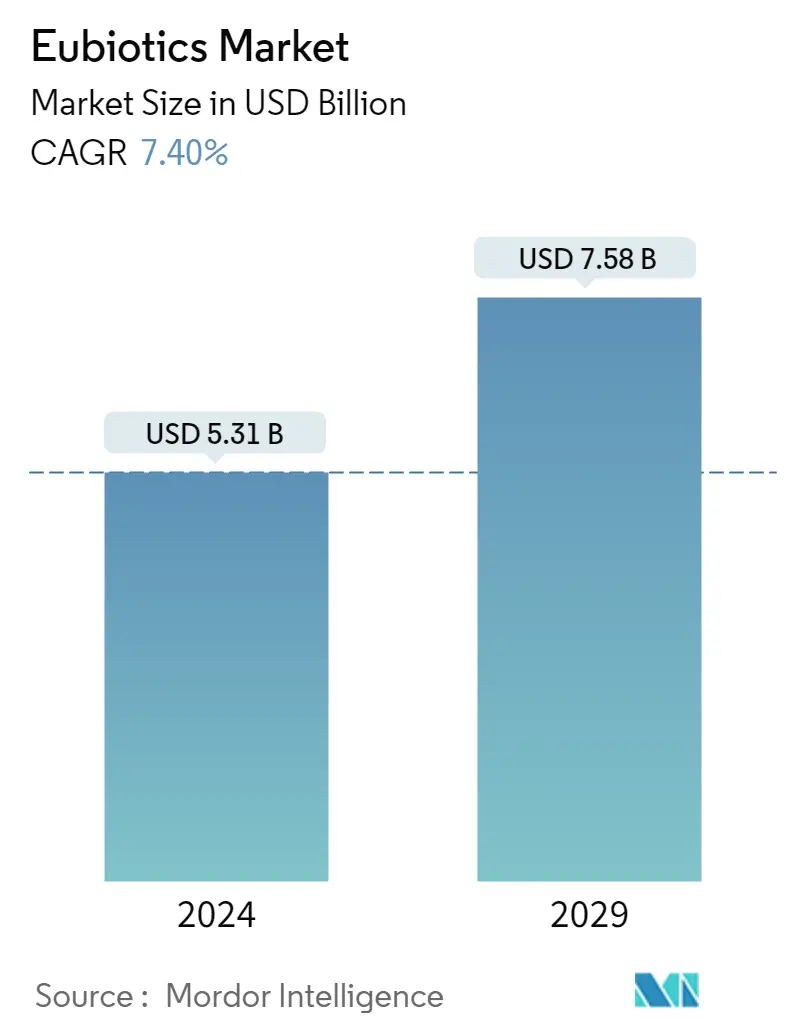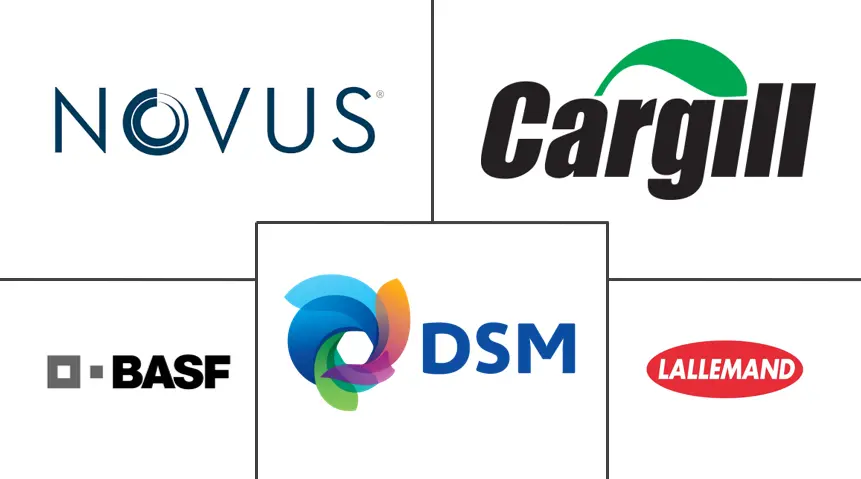Market Size of Eubiotics Industry

| Study Period | 2019 - 2029 |
| Market Size (2024) | USD 5.31 Billion |
| Market Size (2029) | USD 7.58 Billion |
| CAGR (2024 - 2029) | 7.40 % |
| Fastest Growing Market | Asia Pacific |
| Largest Market | Asia Pacific |
Major Players
*Disclaimer: Major Players sorted in no particular order |
Eubiotics Market Analysis
The Eubiotics Market size is estimated at USD 5.31 billion in 2024, and is expected to reach USD 7.58 billion by 2029, growing at a CAGR of 7.40% during the forecast period (2024-2029).
The COVID-19 pandemic moderately impacted the eubiotics industry. The impact was mixed on the industry as the companies suffered economic losses due to social restrictions in the major markets. However, the pandemic resulted in increased awareness about the adverse effects of antibiotics on animals, influencing the market's growth positively.
The eubiotics market is emerging as antibiotic alternatives or antimicrobials byproducts in the animal feed industry, intended to boost livestock's immunity and gut health while acting as livestock nutrition. Manufacturers are focusing on maintaining a balance in the ingredients used in the production of eubiotics to optimize nutrient absorption. In addition, the imposition of bans on antibiotics in North America and Europe, rising prices of natural feed grades, and the use of feed enzymes for cost reduction of feed grades contribute to the market's growth.
Probiotics led the market and account for a major share of the global revenue in 2021. Their demand is driven by their growing utilization, as probiotics produce specific antibacterial substances, resulting in increased immunity. For instance, probiotics, including Enterococcus Faecium, are utilized in several end-use applications, including immunity development and gut health maintenance. In addition, rising awareness concerning the usage of probiotics and strategic initiatives adopted by key manufacturers to generalize the usage of probiotics is anticipated to fuel the product's demand over the forecast period.
Poultry feed emerged as the largest end-use segment and accounted for more than 20% of the global revenue in 2021. Growing demand for poultry meat and concerns over meat quality are driving the segment's growth. There has been a mounting demand for poultry meat and products such as eggs worldwide, thereby compelling poultry industry players to implement competent methods to upsurge yield.
Eubiotics Industry Segmentation
The scope of the report includes eubiotics as a class of feed additives, including prebiotics, probiotics, essential oils, and organic acids. The eubiotics market is segmented by type, animal type, and geography. The report offers market size and forecast in terms of value in USD million for all the above-mentioned segments.
| Type | ||||||
| ||||||
| ||||||
| Organic Acids | ||||||
| Essential Oils |
| Animal Type | |
| Ruminant | |
| Poultry | |
| Swine | |
| Aquaculture | |
| Other Animal Types |
| Geography | |||||||||
| |||||||||
| |||||||||
| |||||||||
| |||||||||
|
Eubiotics Market Size Summary
The eubiotics market is poised for significant growth, driven by its role as a viable alternative to antibiotics in the animal feed industry. This sector is gaining traction due to its ability to enhance livestock immunity and gut health, thereby improving nutrient absorption. The market's expansion is further supported by regulatory bans on antibiotics in regions like North America and Europe, alongside rising costs of natural feed grades and the adoption of feed enzymes. Probiotics, in particular, are leading the market, with their demand fueled by their effectiveness in producing antibacterial substances that boost immunity. The poultry feed segment stands out as the largest end-use category, propelled by the increasing global demand for poultry meat and concerns over meat quality.
The eubiotics market is characterized by a competitive landscape with numerous players, ranging from small to large enterprises, all vying for market share. Companies are actively pursuing strategies such as mergers, acquisitions, and partnerships to expand their geographical presence and product portfolios. Notable industry players like BASF SE, Cargill Inc., and Koninklijke DSM NV are at the forefront, with recent strategic moves aimed at enhancing their eubiotics offerings. The market's growth is also influenced by the industrialization of livestock production, which emphasizes the need for improved feed digestibility to reduce environmental impact. Europe remains a dominant regional market, driven by stringent regulations against antibiotic use and strong demand from key countries.
Eubiotics Market Size - Table of Contents
-
1. MARKET DYNAMICS
-
1.1 Market Overview
-
1.2 Market Drivers
-
1.3 Market Restraints
-
1.4 Porter's Five Forces Analysis
-
1.4.1 Bargaining Power of Suppliers
-
1.4.2 Bargaining Power of Buyers
-
1.4.3 Threat of New Entrants
-
1.4.4 Threat of Substitute Products
-
1.4.5 Intensity of Competitive Rivalry
-
-
-
2. MARKET SEGMENTATION
-
2.1 Type
-
2.1.1 Probiotics
-
2.1.1.1 Lactobacilli
-
2.1.1.2 Bifidobacteria
-
2.1.1.3 Other Probiotics
-
-
2.1.2 Prebiotics
-
2.1.2.1 Inulin
-
2.1.2.2 Fructo-oligosaccharides
-
2.1.2.3 Galacto-oligosaccharides
-
2.1.2.4 Other Prebiotics
-
-
2.1.3 Organic Acids
-
2.1.4 Essential Oils
-
-
2.2 Animal Type
-
2.2.1 Ruminant
-
2.2.2 Poultry
-
2.2.3 Swine
-
2.2.4 Aquaculture
-
2.2.5 Other Animal Types
-
-
2.3 Geography
-
2.3.1 North America
-
2.3.1.1 United States
-
2.3.1.2 Canada
-
2.3.1.3 Mexico
-
2.3.1.4 Rest of North America
-
-
2.3.2 Europe
-
2.3.2.1 Germany
-
2.3.2.2 United Kingdom
-
2.3.2.3 France
-
2.3.2.4 Spain
-
2.3.2.5 Russia
-
2.3.2.6 Italy
-
2.3.2.7 Rest of Europe
-
-
2.3.3 Asia-Pacific
-
2.3.3.1 China
-
2.3.3.2 Japan
-
2.3.3.3 India
-
2.3.3.4 Australia
-
2.3.3.5 Rest of Asia-Pacific
-
-
2.3.4 South America
-
2.3.4.1 Brazil
-
2.3.4.2 Argentina
-
2.3.4.3 Rest of South America
-
-
2.3.5 Middle-East and Africa
-
2.3.5.1 South Africa
-
2.3.5.2 Rest of Middle-East and Africa
-
-
-
Eubiotics Market Size FAQs
How big is the Eubiotics Market?
The Eubiotics Market size is expected to reach USD 5.31 billion in 2024 and grow at a CAGR of 7.40% to reach USD 7.58 billion by 2029.
What is the current Eubiotics Market size?
In 2024, the Eubiotics Market size is expected to reach USD 5.31 billion.

